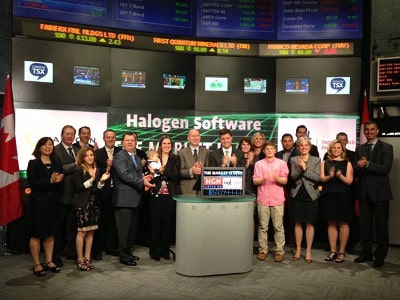Halogen Software CEO Paul Loucks Talks to Cantech Letter

 With Shopify’s recent dual-listed IPO, it’s tempting to look back to some recent entrants into the public market, among whom one finds talent management software maker Halogen, which IPO’d on the TSX in 2013.
With Shopify’s recent dual-listed IPO, it’s tempting to look back to some recent entrants into the public market, among whom one finds talent management software maker Halogen, which IPO’d on the TSX in 2013.
Speaking at the Cantech Investment Conference in January, Halogen CEO Paul Loucks, said, “The interest overall in the tech sector is just as hot and exciting as it was two years ago. It’s part of the reason we went public when we did. Investors were looking for alternatives to get involved with.”
The overall maturity of not only tech companies in Canada, but also of investors, is much greater than it has been at any point since pre-2008 levels, to say nothing of the days when Nortel ruled the TSX during which investors piled indiscriminate money into any company with a .com attached.
And as investors’ sophistication has evolved in the intervening years to winnow out good stories from bad, companies like Halogen have benefited.
Loucks talked at the conference about how Halogen spent the three to five years leading up to their IPO planning for it, learning “how to act like” a public company.
For companies that don’t have an exit as their end goal, the IPO represents the best credible alternative for bringing their business to the next level, following through on the narrative of building a great company, only now at a higher level.
 Cantech Letter talked to Sherwood, P.E.I. native and Halogen CEO Paul Loucks recently to get a little perspective on the challenges of building a company at that level.
Cantech Letter talked to Sherwood, P.E.I. native and Halogen CEO Paul Loucks recently to get a little perspective on the challenges of building a company at that level.
It’s been two years since Halogen IPO’d. How would you characterize that time for your company?
Tremendously successful. I think the IPO was a great thing for our business. When you think about the IPO, a couple things that are benefits that might not be as obvious to everyone are that it’s really quite helpful that you’re getting much more visibility out there. You’re getting visibility with prospects, you’re getting visibility with your existing customers. On top of that, it creates a transparency with respect to things like your financial statements and your viability that allow customers and prospects to understand what the numbers are and that you’re doing well, and that you have that viability from a long-term perspective, whereas a private company’s financial statements don’t have that same transparency or rigor.
On the other hand, that transparency does open you up to the fact that we can see that Halogen lost $4.73 million in your most recent quarter. Are you more concerned about the top line than the bottom line these days?
Let’s start by clarifying that loss. Over $3 million of it was because we had to revalue currency forwards. We buy currency forwards because 75% of our revenue is in U.S. dollars and 75% of our expenses are in Canadian dollars, so the responsible thing to do is to buy currency forwards to make sure that you’ve got that locked in. And what that requires is a revaluation at the end of each quarter based on current market value, ie. the current price of the exchange rate. As the Canadian dollar weakens, you end up with a loss. When the Canadian dollar strengthens, you end up with a gain. It’d probably be more valuable to look at adjusted EBITDA. That aside, when we think about the top line versus the bottom line, it’s really about maximizing the long-term value of the company. And the way to do that is to build the biggest asset of customers and recurring revenue we possibly can, and then harvest that base. Equally important for us is that that base is constantly being boosted by our greater than 100% dollar retention rate. So, build a great base, continue to build it, and recognize that it’s going to be boosted by a greater than 100% dollar retention. When you turn to the harvest side of things, then the question is, will you be able to harvest it and be able to be a highly profitable company? The data point there that shows we will be able to do that is that we have our 70%-plus gross margins and can probably improve on those over time, as we scale. All that said, although top line is incredibly important to build that asset base, we believe you have to do that while being cash-flow-from-operations responsible at the same time.
When you think about managing and optimizing talent, you are optimizing the single biggest business expense in the world. So being able to do this very well is going to be very valuable for your customers.
Of those metrics you just pointed to, what would be the key ones you would point out to investors to demonstrate how Halogen is progressing?
The key metric, if we want to solidify it down to a single one, would be the recurring revenue. If you go back and look over our financial statements, we show a grid, and you can see the growth in that recurring revenue over time. And recognizing that we do have greater than 100% dollar retention on that recurring revenue, it’s just going to keep going up. That’s the math on our utility type of business model. Then it will be about taking that recurring revenue and, again, harvesting it appropriately.
You joined Halogen back in 2000, which is eons ago as far as the tech sector is concerned. In the talent acquisition and management space, what about that process was broken at that time that you saw an opportunity to get into that space?
When you think about managing and optimizing talent, you are optimizing the single biggest business expense in the world. So being able to do this very well is going to be very valuable for your customers. We’re not trying to cut two cents off of every penny here. There are huge dollars in play, and we’re able to help customers optimize that. The other backdrop that you have here is that you’re talking about an environment where distributed work forces are around the world because of web technology really made a big difference to be able to deploy this in a manner that works really well on a worldwide basis. The third thing that’s important from an investor perspective is, what is the total addressable market here? The total addressable market is absolutely huge when you think about the talent management space. We don’t actually compete at the high end of the talent management space. We compete in the mid-market. That is, companies with between 100 and 10,000 employees. So you take the global Fortune 1000 and 2000 out. We’re not pursuing those. There are about 300,000 companies in that space on a worldwide basis. Those companies are only about 10% penetrated at this point in time with talent management solutions, so it’s a huge green field market opportunity. And that opportunity is a $15 billion annual total addressable market.
What’s an example of how Halogen helped make an impact on a company’s bottom line?
This company called Community Care Health, in Milwaukee, Wisconsin, we’ve worked with them for a couple of years and you can see the improvements that they’ve made. They came in with a broken performance management process. People weren’t doing appraisals, people weren’t doing good reviews, people weren’t making sure that their goals were aligned, they weren’t giving good feedback. I can go through the appraisal process with you on an annual basis, and we can tick some boxes and pretend it’s done and move on. Or we can make sure that on an ongoing basis, I’m giving you regular feedback in a constructive and positive manner, so that there are no surprises in the annual checkup and so that we’re establishing strong development plans that are going to help you develop your career. That was more or less the situation that Community Care Health was in, which is a very common situation for our customers to be in.
This is a repeated motif now, no matter who I’m talking to among business leaders who are, for example, transforming the Ed Tech space or marketing or e-commerce or whatever. It feels like the paradigm shift that’s happened since 2008, approximately, is towards a kind of always-on engagement, which reflects this new reality of regular feedback instead of quarterly reports or perfunctory evaluations. You’re in a pretty good position to evaluate whether this is still early days in what is becoming the new normal.
Yes, it’s very early days. The new normal is way better, but it’s work, okay? Go back and ask how you are actually going to get that. It’s through manager development. Think about your leaders and how important it is to build great leaders. One of Halogen’s key components, of helping companies build world-class work forces, is really focused on that leadership development, because you need to be able to build great leaders who understand the value in making sure that they’re doing things very well and on a frequent basis, which drives better business results. So it is very early days, and what you see is some companies doing really well and other companies becoming aware of it and starting to move in that direction.
We are highly predictable. Some people might argue we’re a bit boring. Yeah, but we’re a really great business.
What is a misconception that you encounter about how people perceive Halogen?
From the perspective of the investor, there are two that I notice. One is that investors might have the worry that we can’t be a highly profitable company. But we totally can. The background here is, if we want to be focused on profitability, we wouldn’t be expanding internationally the way we are. We wouldn’t have opened an office in Amsterdam, Dubai, Charlotte and San Jose in the last 24 months, we wouldn’t have been expanding our Sydney and U.K. offices. All of that international expansion is a big investment and ends up on your P&L in your early days. Is it worthwhile from a long-term perspective? Absolutely. But it has a big impact on your P&L. So if you just wanted to grow slower, not build up this highly valuable asset to as big as you possibly can, then you wouldn’t do this. And then all of a sudden, you would see huge profits flow out of this business. The second thing I think people don’t recognize is the fact that, as a company that’s growing, you’re doing a lot of pre-spending. So because you know you’re going to be 20% larger next year than you are right now, you know that you need people to implement your customers. So you have to hire them in advance, you have to train them and bring them up to speed. Again, all in a non-revenue generating way. You have to do your marketing programs in advance. You have to have your sales team and support team brought up to speed in advance of closing the customer. And when you’re in the subscription model, which is again ahead of the revenue because it’s a subscription model and the revenue comes in over a 12 month period, whereas in the old perpetual model it would come in instantly, so there wasn’t that big a lag associated with it. So I think recognizing that this business can and will be tremendously profitable when we get to that very large base and when we change the focus from making sure that we’re maximizing the base, and harvesting the base as much as we possibly can. Another misconception for investors is that we are either going to miss or exceed our guidance by a large margin. The math’s too simple. It’s a rental model. It’s like a utility here. We are highly predictable. Some people might argue we’re a bit boring. Yeah, but we’re a really great business. You should go back and look at the quarterly guidance that we’ve given for recurring revenues and total revenues since we’ve gone public. Look at those and check it against how close we came in the next quarter and you’ll see that we’re within a couple hundred thousand dollars, maybe $100,000. We’re always within $150,000 of our guidance on either side and our guidance is only a $200,000 range. That’s because it’s so predictable, and if you do the math behind it, you’ll sit there and say, “Yep, that’s what they’re going to do this quarter.” And that’s what it’ll be.
Yeah, for me “boring and predictable” has become the new sexy as far as tech companies are concerned. It feels like companies that focus on infrastructure and otherwise boring verticals are the actual future.
Yeah, it may be instructive to compare us to a company like Avigilon. Not predictable, but they’ve got a very attractive market cap, they have huge liquidity and volume in their stock, because they’re not predictable. And boy, do they ever bounce one way or the other after their quarterly earnings. They just do. And we’re sitting here saying we’re boring and predictable. That’s what we are.
Given that you’re so focused on keeping within the guidelines that you set for yourself, what does the next two to three years for Halogen?
There are four main pillars that we want to accomplish. First, obviously continued growth is important. We’ve rolled out offices on a worldwide basis. We need to be able to capture that market share and continue our highly valuable asset, that recurring revenue. We’re going to work towards improving operating efficiencies. We’ve already stated in the February call that in 2016 we’ll be cash flow positive from our operations. We think there’s a balance between building that asset and making sure you do it in a responsible manner. We want to continue to expand our competitive differentiation. We have good competitive differentiation, but it’s important to be able to continue to move that forward. There are lots of good, solid competitors in the marketplace. Finally, we want to make sure we do even more product innovation. No software company can be successful without great software. We have great software, but we have to make sure it’s always going to be great.

Terry Dawes
Writer

